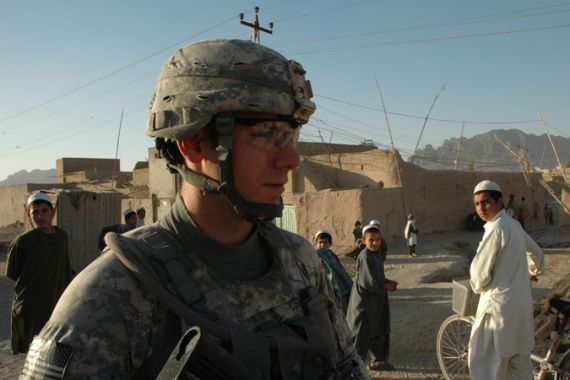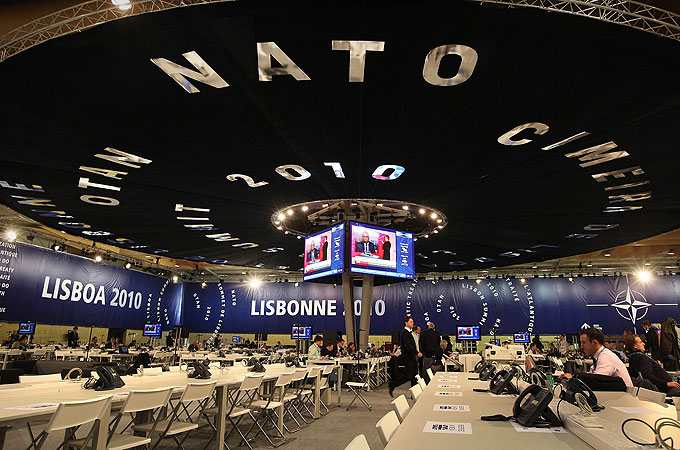Nato ‘to agree’ to Afghan pullout
Nato chief says military alliance plans to hand over control of security to Afghan forces by 2014.

 |
| Nato and its allies are said to be set to endorse a gradual exit plan which would meet a 2014 deadline [Gallo/Getty] |
Nato is to announce a new strategy in Afghanistan that will see the handing over of responsibility for security to Afghan forces from 2011 and allow for significant troop withdrawals by December 2014.
At the beginning of a two-day Nato summit on Friday, Anders Fogh Rasmussen, the military alliance’s secretary general, stated that the plan for a gradual withdrawal of most of the 150,000 foreign troops would be announced during the meeting in Lisbon, the Portuguese capital.
Rasmussen said that the 28-nation alliance was committed to the 2014 target date, despite comments from some officials at Nato and in the US that it was too ambitious considering the strength of the Taliban at present.
“We will announce that the transition to lead Afghan responsibility [for security] is about to start in 2011,” Rasmussen said.
“We hope this process will be completed by the end of 2014 so that the Afghan security forces can take responsibility all over Afghanistan.”
‘Aspirational goal’
Geoff Morrell, the Pentagon’s press secretary, said on Thursday the US was hopeful that Afghan forces would be able to take the lead for security across the country within four years, but foreign forces might remain beyond the target date.
“So, 2014 has been out there for quite some time as an aspirational goal for us to meet in terms of ultimately putting the Afghan security forces in the lead, having primary responsibility for the security of their country,” Morrell said.
However, Rasmussen suggested that mosty of the staff left in the country after the proposed withdrawal would be there to train Afghan security forces.
“I see a role for troops after 2014 but with a focus on training security forces,” he said.
The exit strategy hinges on the ability to build-up Afghan forces, with a target strength of more than 300,000 by the end of 2011.
Nato’s training of about 134,000 Afghan police and 170,000 soldiers by next October is seen as vital towards ensuring the withdrawal of foreign troops.
But this has been hampered by high desertion rates and the Afghan government is widely seen as too corrupt, unstable and inept to survive long without foreign military support.
‘Not very realistic’
Marco Vicenzino, the executive director of the Global Strategy Project, told Al Jazeera that he thought the 2014 date was “not very realistic”.
 |
| Thousands of anti-Nato activists are planning to stage a protest march during the weekend summit [EPA] |
“Much of this is driven by and motivated by domestic and internal needs of many of the leading countries, including the United States,” he said.
Vicenzino said that both the 2011 and 2014 targets for handing over security were “counter-productive”.
“They incentivise the insurgency to hold out as long as they can and disincentivise ordinary Afghans from wanting to collaborate and participate with the Nato mission.”
There are 46 countries with troops in Afghanistan, totalling nearly 131,000 soldiers, most of them from the US, Britain, Germany, France, Italy, and Canada.
Separately Barack Obama, the US president, said at the summit that Nato had agreed to his plans for a new, expanded missile defense system for Europe that would cover all Nato member countries and the US.
‘Wide agenda’
The bigger, strategic question of Nato’s future role beyond Afghanistan was also raised as the summit got under way.
Rasmussen brandished a revamped mission statement that was approved by the leaders of the alliance’s 28 member states as he gave a news conference on Friday.
The new blueprint, known as Nato’s Strategic Concept, redefine its role in the 21st century to combat new threats that include insurgency, terrorism and ballistic missiles.
Rasmussen said it ensures the 61-year alliance remains “as effective as ever in defending our peace and security”.
Al Jazeera’s Laurence Lee, reporting from Lisbon, said this was the first redrafting of what Nato is about for 11 years.
“It is designed to mirror the fact that the world is changing very fast,” he said.
“[Rasmussen] did his best to talk up the point of Nato… he reaffirmed article five of the constitution that says that an attack on one Natio state is an attack on the others … and he said they had learned some lessons from Afghianistan.”
‘Political identity’
But Beverly Crawford, a professor of political science at the University of California, Berkeley, told Al Jazeera that Nato faces “huge problems”.
“Economic problems and economic crises throughout Europe and throughout the United States are stretching [Nato’s] capabilities very thin,” she said.
“And as they get stretched thin, especially in Europe, the gap between Europe and the United States grows bigger and bigger all the time, and at the same time Afghanistan is sapping Nato’s credibility right now.”
Crawford said Nato’s identity was in doubt and that it has been for the past 20 years.
“Nato was formed in 1949 as a defensive alliance against the Soviet Union,” she told Al Jazeera.
“When the Soviet Union fell, Nato searched for a political identity as a political actor, as a political organisation and then Nato took on the role of out-of-area missions. And it seems to me that it’s role has been stretched extremely far now.”